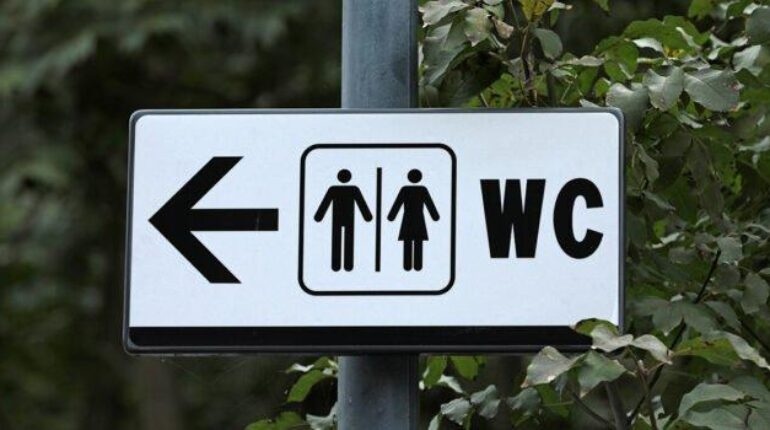📌 The bathroom sign mystery everyone sees but never questions: What ‘WC’ actually stands for

Posted 14 July 2025 by: Admin
The Viral Mystery That Left Americans Confused About Bathroom Signs
A simple walk past a public restroom sign sparked a cultural revelation that would captivate millions online. In 2020, TikTok couple Shelby and Dylan stumbled upon a linguistic mystery that exposed deep differences in how North Americans describe the most universal of human needs.
“What in the world is a washroom?” Dylan asked, genuinely perplexed as he encountered the unfamiliar signage. His confusion was immediate and authentic. “And what are they washing in there? Oh, it’s a restroom. The only thing I wash in there is my hands.”
But Shelby’s counter-question proved equally revealing: “Do you rest in a restroom?”
The exchange struck a nerve. Dylan’s response captured the absurdity perfectly: “That’s a good point. They both don’t make much sense.”
Their viral video ignited a global conversation about bathroom terminology that revealed surprising regional divides. Comments flooded in from users worldwide, each defending their preferred term. “It’s called a bathroom, restroom, washroom and toilet,” one user offered, highlighting the linguistic chaos.
The confusion wasn’t limited to social media debates. One follower shared a memorable real-world mishap: when visiting Disneyland, they “asked for the washroom” and staff “sent me to the laundromat!”
Yet perhaps the most intriguing comment hinted at an even deeper mystery. “Wait ’til he finds out about water closets,” wrote one user, introducing the cryptic WC abbreviation that appears on countless signs worldwide.
This simple TikTok moment had uncovered something profound about how language shapes our most basic human experiences.
Water Closet: The Formal Definition Behind the Mysterious WC
The mysterious WC that puzzled Dylan and countless others has a surprisingly straightforward explanation. According to Merriam Webster’s Dictionary, “water closet” is a noun that describes “a compartment or room with a toilet” or “a toilet bowl and its accessories.”
This definition reveals a crucial historical distinction that most people never consider. Back in the day, when someone used the bathroom, it was literally to take a bath. When a person used a restroom, it was to rest or get ready for the day using the sink and mirror.
But if you needed to go potty? You would use the toilet in the water closet.
This separation made perfect sense in an era when different rooms served distinct functions. The water closet was specifically designed to house the porcelain throne, often as a separate, enclosed space within larger homes.
Today, the WC abbreviation appears on signage across public spaces worldwide. Airports, restaurants, and hotels frequently use this universal designation to communicate with international travelers who might not understand regional terms like “restroom” or “washroom.”
The term serves as a formal, internationally recognized way of saying “toilet facility” without the cultural baggage that confused Dylan and Shelby. Whether you call it a loo, lavatory, or bathroom, the WC provides a standardized solution for a universal human need.
This linguistic evolution reflects a fascinating journey from luxury amenity to everyday necessity.
From Luxury To Necessity: The 19th Century Bathroom Revolution
This journey from luxury to necessity tells a remarkable story of social transformation. Before the 19th century in America, indoor toilets were an exclusive privilege reserved for the wealthy elite. Most people relied on outhouses or outdoor facilities for their sanitary needs, regardless of weather or season.
The contrast was stark. While affluent homes often featured dedicated “bathrooms” for bathing, these rooms typically didn’t include toilets. The porcelain throne remained banished to separate quarters, creating a clear division between cleansing and relieving functions.
Everything changed with the widespread installation of indoor plumbing. By 1890, the advent of the water closet revolutionized American homes. These innovative rooms housed toilets separately from bathing spaces, maintaining the historical distinction between different bodily functions.
The early 20th century brought the next major evolution. The modern bathroom emerged, combining both bathing facilities and toilets into one integrated space. This arrangement solved practical problems – saving space and simplifying plumbing systems throughout homes.
However, this consolidation came with trade-offs. Privacy was reduced, especially in shared living spaces where multiple family members needed access to different facilities simultaneously.
The term “water closet” evolved accordingly, now referring to a small, enclosed room within larger bathrooms, dedicated solely to the toilet. These spaces often included small sinks for handwashing, creating self-contained and convenient facilities.
This transformation reflects broader social changes – from exclusive luxury to universal necessity, reshaping how entire societies approached personal hygiene and domestic architecture.
Global Bathroom Linguistics: From Russian “Windowless Rooms” To Esperanto’s “Necessary Place”
This architectural evolution sparked a fascinating linguistic phenomenon worldwide. As societies modernized their sanitation systems, they developed distinctly different names for the same essential space.
The mystery deepened when Reddit users attempted to demystify the water closet in a post titled “Why is a public WC called bathroom if there is [no] bath?” Their responses revealed the remarkable diversity of global bathroom terminology.
One Redditor offered clarity: « Americans might similarly ask: ‘Why is it called a WC (water closet) if it isn’t even a closet?’ » The explanation continued that “bathroom” or “restroom” represents the « preferred US euphemism for ‘room with toilet,’ whereas other places use ‘WC,’ ‘lavatory,’ ‘loo’ etc. »
Cultural creativity flourished in unexpected ways. Russian speakers coined the term “room without windows” – even when windows actually exist. Meanwhile, Esperanto developed “necesejo,” translating to « necessary place » – perhaps the most honest description of all.
Regional preferences emerged clearly through user discussions. « Canada famously uses Washroom, » noted one netizen, while a Midwest American clarified: « I’m from the midwest, and washroom is fairly common here. Bathroom or restroom are probably used the most though. »
The practical logic wasn’t lost on users. « Best one, I think. You should be washing in there, » added another commenter about “washroom,” emphasizing « …not resting. »
This global linguistic tapestry reveals how universal human needs inspire remarkably diverse cultural solutions, each reflecting unique societal perspectives on privacy, function, and social etiquette.




















